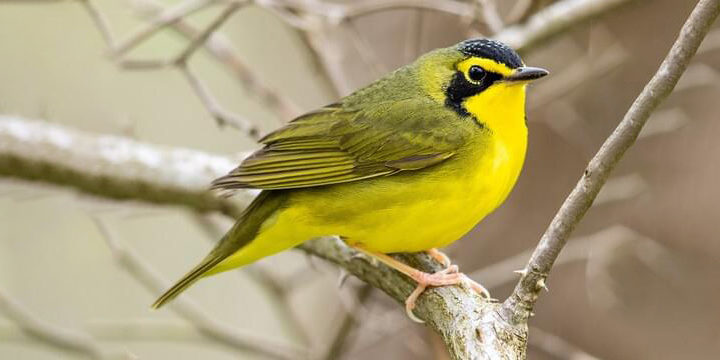Bird of The Week: Kentucky Warbler
Scientific Name: Geothlypis formosa
Population: 2.5 million
Trend: Decreasing
Habitat: Breeds in deciduous woods with thick understory; winters in lowland and foothill forests
The furtive, beautiful Kentucky Warbler is a sought-after springtime sighting throughout the eastern U.S. Like the Wood Thrush and Ovenbird, this inhabitant of deep, damp forests is more often heard than seen.
A patient observer may eventually track the song to its source: a long-legged, short-tailed bird colored olive-green above and bright lemon-yellow below, with a distinctive black facial pattern that makes the bird look like it has sideburns.
Named by a Naturalist
The Kentucky Warbler was first seen by the Scots-American naturalist and ornithologist Alexander Wilson in 1810. Wilson named this bird for the mostly forested state where he found it. It was one of dozens of species he introduced to the world, through words and illustration, in the first thorough treatise on U.S. birds, entitled American Ornithology. In it, he also described five species now bearing his name: Wilson’s Plover, Wilson’s Snipe, Wilson’s Storm-Petrel, Wilson’s Phalarope, and Wilson’s Warbler.
Wilson’s first encounter with the Kentucky Warbler was most likely the same as most birders’ – he probably heard its rich, rollicking song: “churry churry churry.” While defending nesting territory, males sing persistently, repeating themselves as often as once every 12 seconds. Given its resonance and repetition, the Kentucky Warbler’s song can be a fairly common springtime sound in forested regions where this species occurs. However, this territorial vocalization can be easily confused with that of the warbler’s frequent neighbor, the Carolina Wren. It takes some practice, but many birders learn that song quality and clarity differ between the two species, with the “syllables” of the Kentucky’s two-note song phrases almost blurring together, unlike the wren’s usually distinct notes.
A Liking for Lowland Forests
During its breeding season, the Kentucky Warbler can be found in deep, deciduous forests in the East, with populations, overall, denser and more widespread west of the Appalachians. This skulking species requires forest with a dense understory, usually close to water such as creeks, rivers, and swamps. It seeks similar lowland and lower foothill forest habitat on its wintering grounds in Mexico, Central America, and extending as far south as Venezuela and Colombia.
Scratching Up a Meal
The Kentucky Warbler forages on the ground on long, pink legs, searching for grubs, spiders, caterpillars, and other invertebrates. It probes forest litter in the manner of a Spotted Towhee, tossing leaves aside with its bill and scratching with its feet. It may also dart into shrubs, vines, and the lower parts of trees to glean insects. Like the Bay-breasted Warbler, this warbler may also add small fruits to its diet during the winter.
Kentucky Warblers often follow swarms of army ants while on their wintering grounds, snapping up invertebrates fleeing the swarm. This foraging tactic is commonly used by many resident species of humid tropical forests, such as antbirds and the Fan-tailed Warbler, among others. Kentucky Warblers will defend a small foraging territory during the winter, fiercely driving away others of their kind.
Threats: A One-Two Punch
While courting, male and female Kentucky Warblers chase each other while uttering loud, rapid chip notes. Once mated, the female selects a nest site on the ground near the base of a tree, or near ground-level in a thick shrub. Both sexes build the open cup nest out of dead leaves lined with soft grasses, hair, and rootlets. The female alone incubates, but the male helps to feed the young once they hatch.
As with other ground-nesting songbirds such as the Kirtland’s Warbler, nests of Kentucky Warblers are frequently parasitized by Brown-headed Cowbirds, especially in fragmented forests, which give the cowbirds easy access.
Declining Due to Deer
One of the biggest threats to the Kentucky Warbler is habitat loss and degradation, particularly the disappearance of forest understory caused by over-abundant White-tailed Deer. In a one-two punch, the species also has to contend with habitat loss on its wintering grounds. Partners in Flight has placed the Kentucky Warbler on its Yellow Watch List of declining birds, noting a 29-percent drop in population between 1970 and 2014.
ABC is involved in a number of large-scale conservation initiatives that benefit Kentucky Warblers, including BirdScapes, Joint Ventures, and Southern Wings. All of these programs concentrate on the protection, recovery, and enhancement of suitable habitat on the Kentucky Warbler’s breeding and wintering grounds.
Other ABC initiatives tackle threats affecting all birds, including our Cats Indoors program, which encourages pet owners to keep cats and birds safe, and our Glass Collisions program, which offers solutions to keep migrating birds from hitting windows.
Source: American Bird Conservancy (abcbirds.org)


